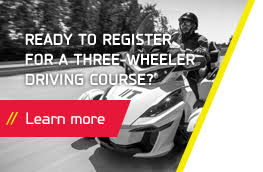Phase 4 : Semi-guided to independent driving
Your learner is now ready to begin phase 4 of the RSEP program.

And yes, this is the last phase of the program. (In other words, you may soon be able to definitively quit your job as the family taxi driver!)
During this final phase, the learner will complete two theoretical modules on the following topics:
- fatigue and distractions;
- eco-driving.
The learner will also have 5 practice sessions with the driving school, the last of which will be his final evaluation.
Your learner is falling behind in his training program?
If your learner falls behind in his training, we recommend that you:
- Go out for more practice sessions with him;
- Speak with the driving school if you are having a hard time holding practice sessions with your learner. It should be able to provide further training;
- Identify the specific maneuvers that your learner should further practice. In fact, for each practice session, he will receive an e-mail with details of the maneuvers he should practice. It is recommended that you integrate these into your sessions with him;
- During an upcoming course, speak with the driving instructor to obtain advice on your learner’s specific situation.
This phase is completed over a minimum of 56 days.
Towards independant driving

The practice sessions in phase 4 are semi-guided to independent driving sessions. During this entire phase, the learner must be able to independently perform a wide range of maneuvers. The more he advances in this phase, the closer he should be to full independence (the time when he will no longer need instructions from you to be able to successfully complete various maneuvers, observe and evaluate different driving scenarios, and determine the best behaviours to adopt and act accordingly).
In other words, you should be on the brink of becoming an active passenger (rather than an accompanying rider) for most driving scenarios. The roles will now be inverted!
The time has come for your learner to be fully independent. In addition to driving and knowing what behaviour to adopt while behind the wheel, the learner should now be able to carry out a basic check of the vehicle. This verification includes checking the oil level, windshield washer fluid, lights, battery, gas gauge, etc.
Advice for helping the learner be even more independent:
- Let the learner personally choose the route of a practice session.
- Give him fewer instructions as the number of practice sessions increase (and none whenever possible).
- Allow the learner to describe the route he is considering taking and as he sets off, the actions he adopts and why.
- Let him fill up the gas tank (show him how if necessary).
- Let him add windshield washer fluid (show him how if necessary).
- Explain him how to jumpstart (boost) the vehicle.
P.-S.: Did you know that there is now a way of boosting a vehicle that doesn’t require the assistance of another vehicle? Check out: https://boostmi.com.
Watch two last videos
Near the end of this phase, you will be invited to watch two last videos. The first video will focus on the consequences of drunk driving. The second video will focus on the importance of making a team with your learner driver. However, as your learner is just about to receive his probationary licence, we would like you think about this scenario that emphasizes the importance of good communications as a means of avoiding critical situations. Your learner will also watch these videos during his classroom sessions. Please be advised that these are hard to watch if you’re sensitive.
The goal at this point is to discuss various topics with the learner, talk about the risks inherent to driving, and continue to provide him with positive feedback in various areas.
VEHICLE RENTAL SERVICE FOR THE SAAQ TEST
 Did you know that Tecnic rents vehicles for learners to pass the SAAQ’s road test?
Did you know that Tecnic rents vehicles for learners to pass the SAAQ’s road test?
This has many benefits:
- The Tecnic rental vehicle is already on site when the learner goes to take his test.
- The SAAQ has inspected the vehicle ahead of time.
- The learner is used to driving with this type of vehicle (it’s what was used during his driving courses).
- The vehicle is insured by Tecnic.
- The vehicle is equipped with a brake for the driving examiner.
Always stay vigilant when in a vehicle with the learner, even if the latter is at the very end of his program. Go to Phase 2 in the Toolbox to read over a few tips and advice one last time.
A few reminders
To avoid being blinded by glaring lights...
To avoid being blinded by glaring lights when you meet another vehicle, you can either look towards the right side of the road or slow down if the lights are extremely bright.
Tips for driving in rain or snow
When driving in rain or snow, it’s important to use your low beams to see better and to be more easily seen by oncoming vehicles. This is true even in the daytime.
When another vehicle is passing you and you fear there will be a collision...
Whenever another vehicle is passing you and you fear there may be a head-on collision, slow down to allow the passing vehicle to get in front of you. Should this same vehicle look like it wishes to get behind you again, speed up a bit to allow the driver to do so safely.
Merging onto a highway
In Québec, the vehicle that merges on a highway must yield the right-of-way to cars already on the road.




